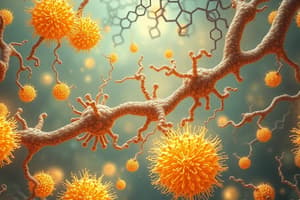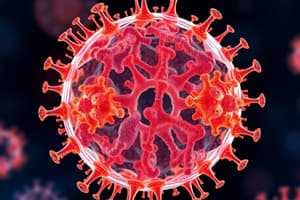Podcast
Questions and Answers
Which of the following is NOT an essential element required for bacterial structure?
Which of the following is NOT an essential element required for bacterial structure?
- Hydrogen
- Carbon
- Sodium (correct)
- Nitrogen
What is the primary function of catabolism in microbial metabolism?
What is the primary function of catabolism in microbial metabolism?
- Synthesis of macromolecules
- Release of energy (correct)
- Regulation of biochemical reactions
- Lowering activation energy
Enzymes are crucial in biochemical reactions because they:
Enzymes are crucial in biochemical reactions because they:
- Provide energy to the reaction
- Change the end products
- Are consumed in the reaction
- Lower the activation energy (correct)
Which of the following statements about metabolic pathways is TRUE?
Which of the following statements about metabolic pathways is TRUE?
Which type of reaction provides energy for anabolic reactions?
Which type of reaction provides energy for anabolic reactions?
What role do minerals play in bacterial growth?
What role do minerals play in bacterial growth?
Which process is characterized by the build-up of macromolecules and cell organelles?
Which process is characterized by the build-up of macromolecules and cell organelles?
How do enzymes regulate biochemical reactions?
How do enzymes regulate biochemical reactions?
What is the primary purpose of glycolysis?
What is the primary purpose of glycolysis?
During glycolysis, what is the product formed from one molecule of glucose?
During glycolysis, what is the product formed from one molecule of glucose?
Which metabolic pathway is specifically generated for nucleotide synthesis?
Which metabolic pathway is specifically generated for nucleotide synthesis?
What is produced when glucose 6-phosphate is processed in the pentose phosphate cycle?
What is produced when glucose 6-phosphate is processed in the pentose phosphate cycle?
What type of metabolism is used by facultative anaerobes to utilize hexoses?
What type of metabolism is used by facultative anaerobes to utilize hexoses?
Which pathway is NOT involved in the breakdown of glucose?
Which pathway is NOT involved in the breakdown of glucose?
What do all cells primarily convert food energy into?
What do all cells primarily convert food energy into?
What can cause enzyme denaturation?
What can cause enzyme denaturation?
What do competitive inhibitors primarily affect in a metabolic pathway?
What do competitive inhibitors primarily affect in a metabolic pathway?
Which statement is true about the cofactors required for redox reactions?
Which statement is true about the cofactors required for redox reactions?
What effect do inhibitors have on enzyme activity?
What effect do inhibitors have on enzyme activity?
How do changes in enzyme or substrate amounts influence biochemical reactions?
How do changes in enzyme or substrate amounts influence biochemical reactions?
What are coenzymes?
What are coenzymes?
Which factor does NOT affect enzyme activity?
Which factor does NOT affect enzyme activity?
What leads to the inactivation of an enzyme?
What leads to the inactivation of an enzyme?
Which of the following enzymes require non-protein cofactors for functionality?
Which of the following enzymes require non-protein cofactors for functionality?
What is the primary function of the Calvin cycle in the dark reaction?
What is the primary function of the Calvin cycle in the dark reaction?
Which of the following correctly describes oxygenic photosynthesis?
Which of the following correctly describes oxygenic photosynthesis?
What characterizes anoxygenic photosynthesis compared to oxygenic photosynthesis?
What characterizes anoxygenic photosynthesis compared to oxygenic photosynthesis?
Which of the following statements about the light reactions is incorrect?
Which of the following statements about the light reactions is incorrect?
Which of the following products could be formed from the metabolic pathways mentioned?
Which of the following products could be formed from the metabolic pathways mentioned?
What is the main difference between the Entner-Doudoroff pathway and classic glycolysis?
What is the main difference between the Entner-Doudoroff pathway and classic glycolysis?
Which fermentation pathway is characterized by pyruvate being reduced to lactic acid?
Which fermentation pathway is characterized by pyruvate being reduced to lactic acid?
What product results from the Entner-Doudoroff pathway?
What product results from the Entner-Doudoroff pathway?
What is the key enzyme involved in the phosphoketolase pathway?
What is the key enzyme involved in the phosphoketolase pathway?
Which of the following organisms is known for carrying out mixed acid fermentation?
Which of the following organisms is known for carrying out mixed acid fermentation?
What is produced during the light-dependent reactions of photosynthesis?
What is produced during the light-dependent reactions of photosynthesis?
In which type of autotrophic process is light energy utilized?
In which type of autotrophic process is light energy utilized?
Which end product is NOT generated from the phosphoketolase pathway?
Which end product is NOT generated from the phosphoketolase pathway?
Flashcards are hidden until you start studying
Study Notes
Microbial Metabolism
- Microbial metabolism encompasses the biochemical reactions for energy generation (catabolism) and biosynthesis (anabolism).
- Catabolism releases energy, often stored as ATP (adenosine triphosphate).
- Anabolism consumes energy, utilizing ATP.
- Metabolic pathways are series of enzyme-catalyzed reactions.
- Enzymes accelerate reactions without being consumed, lowering activation energy.
Nutritional Requirements
- Essential elements for bacterial growth include carbon (C), hydrogen (H), oxygen (O), nitrogen (N), phosphorus (P), and sulfur (S).
- Minerals like potassium, calcium, magnesium, iron, copper, cobalt, manganese, molybdenum, and zinc are needed in trace amounts.
Enzyme Activity Control
- Enzyme activity is controlled by:
- Enzyme and substrate concentration.
- Temperature, pH, and salt concentration.
- Cofactor availability.
- Inhibitors (competitive, binding to the active site; allosteric, binding elsewhere).
- Enzyme denaturation occurs when changes in temperature, pH, or salt concentration disrupt the protein's structure.
- Mutations can also lead to misfolded, non-functional enzymes.
Redox Cofactors
- Redox reactions often require cofactors like NAD (nicotinamide adenine dinucleotide) and FAD (flavin adenine dinucleotide) to shuttle electrons.
- NAD and FAD are regenerated to maintain metabolism.
- Cofactors can be metal ions, vitamins, or other non-protein molecules. If organic, they're called coenzymes (often vitamins).
ATP and Glycolysis
- ATP is the preferred energy source for all cells; breaking the bond of its third phosphate releases energy.
- Glycolysis catabolizes sugars (like glucose) into two 3-carbon pyruvate molecules, yielding 2 ATP and 2 NADH per glucose.
Glycolytic Pathways
- Four major glycolytic pathways exist in bacteria:
- Embden-Meyerhof-Parnas (EMP) pathway: Glucose → 2 pyruvate + 2 ATP + 2 NADH. Common in many organisms.
- Pentose phosphate pathway (also called hexose monophosphate pathway): Generates NADPH and pentose phosphates for nucleotide synthesis. Glucose 6-phosphate + 2 NADP+ + H2O → ribulose 5-phosphate + 2 NADPH + 2H+ + CO2
- Entner-Doudoroff pathway: Glucose → 2 ethanol + 2 CO2 + 1 ATP; used by bacteria lacking some glycolysis enzymes.
- Phosphoketolase pathway: Glucose → 1 lactate + 1 ethanol + 1 CO2 + 1 ATP; used in dairy fermentation.
Fermentation
- Organisms recycle NAD+ through various fermentation pathways, producing diverse end products:
- Lactic acid fermentation (e.g., Streptococcus, Lactobacillus)
- Mixed acid fermentation (e.g., Escherichia coli)
- 2,3-Butanediol fermentation (e.g., Enterobacter aerogenes)
Respiration and Chemiosmosis
- (Details not provided in the text)
ATP Production Summary
- (Details not provided in the text)
Photosynthesis
- Autotrophs produce organic molecules from inorganic carbon (CO2); heterotrophs require organic carbon sources.
- Energy sources for autotrophs include:
- Light (photoautotrophs, performing photosynthesis)
- Chemicals (chemoautotrophs)
Light-Dependent Reactions: Photophosphorylation
- Light energy is harvested by pigments, transferred to chlorophyll reaction centers (photosystems).
- Light energy strips electrons from a donor, shuttling them through electron carriers to generate ATP.
- Cyclic pathways return electrons to the transport chain; non-cyclic pathways use them to reduce NAD(P) to NAD(P)H.
Dark Reactions (CO2 Fixation)
- ATP and NADPH from the light reactions drive CO2 fixation via the Calvin cycle to form carbohydrates.
- These reactions produce key monomers for anabolic reactions.
Oxygenic vs. Anoxygenic Photosynthesis
- Oxygenic photosynthesis (cyanobacteria, chloroplasts): Uses H2O as an electron donor, producing O2; involves two photosystems (PSII and PSI).
- Anoxygenic photosynthesis (various bacteria): Electron donors vary (H2S, SO, H2, or organic compounds); typically involves a single photosystem, mainly for ATP production via cyclic photophosphorylation.
Studying That Suits You
Use AI to generate personalized quizzes and flashcards to suit your learning preferences.




